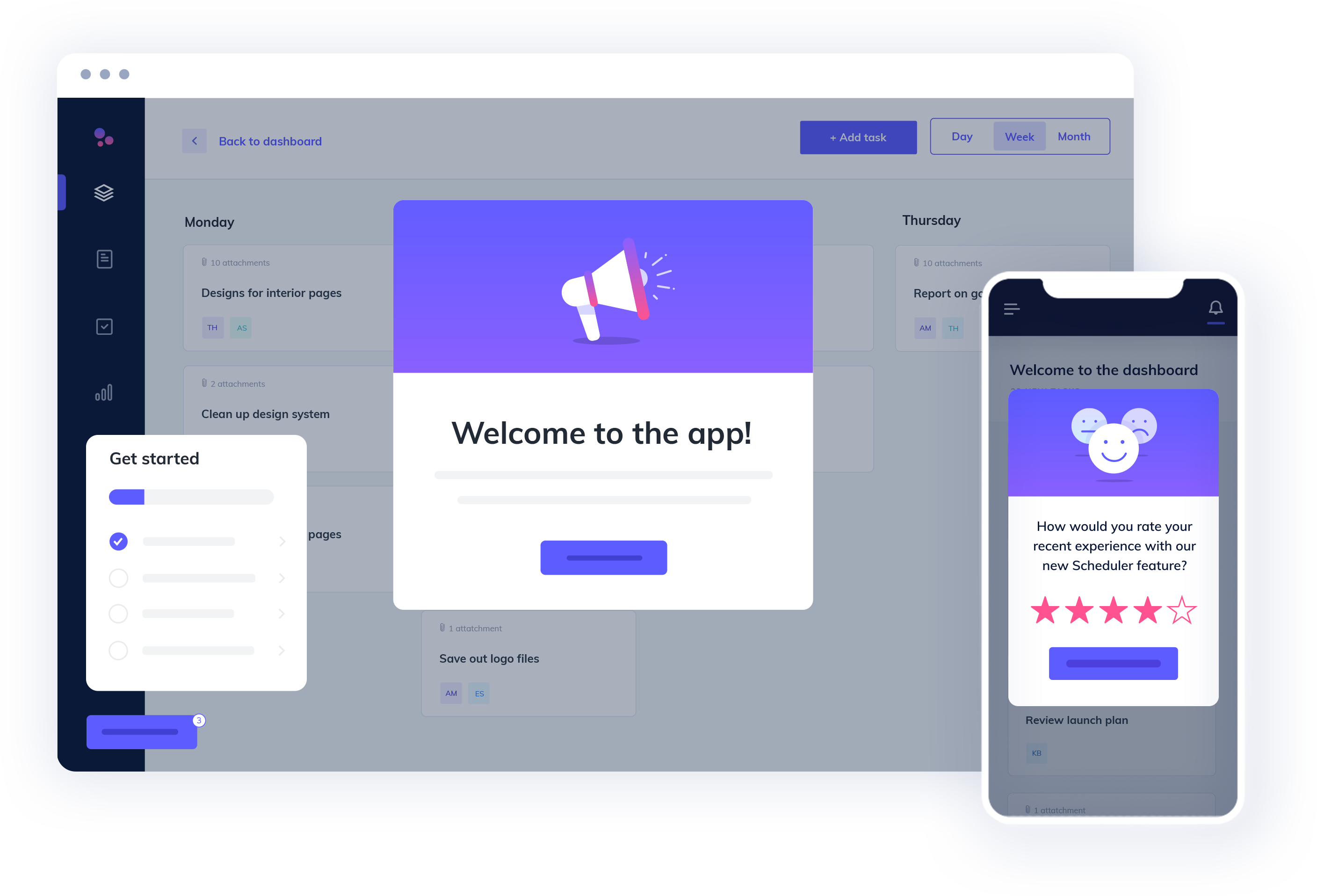What is a user onboarding tool?
User onboarding tools are dedicated pieces of software designed to help you educate new users about how to use your product. These platforms help you create an onboarding experience that wows new users and convinces them to adopt your product.
The most common types of product onboarding tools are:
- In-app experience onboarding tools (such as Appcues)
- Email and Sales onboarding tools (Mailchimp)
- Analytics onboarding tools (Segment)
- User testing onboarding tools (UserTesting)
- Customer service onboarding tools (Zendesk)
1. Identify your critical retention event
The first time a customer realizes the true value of your product is often called an “aha!” moment because it fundamentally changes their relationship with your product. Through one critical retention event, the user goes from hoping your product will alleviate their pain points to understanding how it’ll do so. To find your retention event, answer the following questions:
- What user groups use your product? Does each segment find value in the same or different actions?
- Is there a single action that you want a user to take every time they are in your product?
- What metrics are you measuring as a company? Are there user actions that impact those metrics?
- What behavior do your best customers perform?
Set goals for your onboarding experiences with Appcues. Try it now >>
2. Research your customers
Good customer research enables companies to build products and experiences that speak directly to what users want and need. When you research your customers before optimizing your onboarding process, you’ll get a better understanding of what draws them to your product in the first place. To do this use:
- Qualitative data: customer interviews, surveys, focus groups
- Quantitative data: product analytics, useability testing, feedback from other departments
Measure success of your onboarding flows with Appcues. Try it now >>
3. Build a product tour
Product tours and walkthroughs help prevent customers from getting lost on the way to their aha moment. The best product tours provide guidance in the fewest steps possible. Too many in-app messages can actually break a user’s experience instead of smoothing it over.
- Map out the path to value for a new user
- Break the journey up into bite-sized steps to motivate the user to keep going
Build a product tour in minutes with Appcues. Try it now >>
4. Personalize the user onboarding experience
Everyone comes to your product from different experiences and with different agendas, and your onboarding experience should reflect this. To maximize personalization, implement separate onboarding flows for users with different preferences, demographics, or behaviors.
- Segment your users into groups based on how they use your product
- Create personalized experiences for each group and then iterate over time
Personalize onboarding at scale with Appcues. Try it now >>
5. Write a killer welcome email
Welcome emails do more than offer a warm hello to your newest customers for a good first impression. A finely crafted welcome email greets users at the stage of their life cycle when they’re most engaged with your brand.
- Write a personalized and punchy subject line
- Show off your brand voice in the email
- Include a simple and effective CTA (plus test it over time)
Align your emails with in-app messages with Appcues. Try it now >>
6. Maintain communication
Even the most effective onboarding process is likely to lose a few new users along the way. You should monitor your customer’s behavioral data as they make their way through onboarding to see who has stopped progressing and requires a push in the right direction.
- Monitor user behavior to see if they have dropped off the onboarding journey
- Send in-app nudges to refocus users who haven't completed essential tasks
- Create email reminders to re-engage users who stopped using the product
Send personalized in-app nudges with Appcues. Try it now >>
7. A/B test your onboarding flows
Sometimes the best way to retain new users is to tweak your onboarding flows. Usability tests will reveal some of the more obvious flaws in your current process, but they can only test what’s already there. A/B testing helps determine how changes to onboarding flows impact the customer journey.
- Build a cohort of users and test their activation rate with your current flow
- Create a cohort of similar users and send them through a new version
- Measure conversion rates for each cohort
- Continue testing by separating your users into segments
A/B test in-app experiences with Appcues. Try it now >>
Studies show that a 5% increase in customer retention rate can increase profitability by 25%. That doesn't include the value of a satisfied customer’s positive word-of-mouth as they praise your product to six or more people they know.
"In the end, investing in Appcues was a drop in the bucket. At this point, it has probably saved us months of engineering time.”
Peter Clark
Prior Director of Product Growth
“Appcues Checklists has been a game-changer for us. We never thought that we could 2X our free trial conversion with such minimal effort.”
Ezra Sandzer-Bell
Customer Success Engineer
Right now, your product is your most valuable growth lever.
Lower customer acquisition costs (CAC)
Guiding users to value quickly improves activation and free-to-paid conversion rates. The faster you can show value and make an impact for a propsect, the more likely they are to buy.
Increase customer lifetime value (LTV)
Making your product easy to use decreases churn and helps boost expansion. Plus, targeted in-app nudges can motivate champions to expand, which can help offset churn and improve gross margin.
Become more efficient as a business
Personalize your message at scale without taking up precious engineering resources. Do more with less by allowing your team to focus on the highest impact work and automating the rest.

